
| |
|
 |
|
The "Ten Oxherding Pictures" |
|
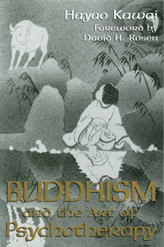 |
|
| There are various versions of "Oxherding Pictures". Here, we show the version on which Prof.
Hayao Kawai spoke at the Fay Lecture and later compiled into his book "Buddhism and the Art of Psychotherapy"
(Texas A & M University Press, p. 36-44, 1996), with his
comment as Jungian analyst. This version of the "Oxherding Pictures" is painted by the fifteenth-century Japanese painter Shubun, based on the ideas of Kuo-an, who was a Chinese Zen master in the 12th century. At present, these pictures are in the possession of Shokoku-ji, Kyoto, Japan. |
|
What I like about this series of pictures is that, one by one, they provoke our imagination. - Hayao Kawai |
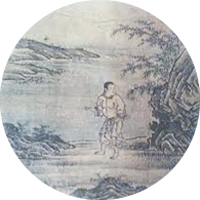 |
...I
shall sketch only a brief background. This traditional series of pictures
illustrating development in Zen practice is called "Ten Oxherding
Pictures" or simply the "Oxherding Pictures," as there
are not necessarily ten. Although their origin is unknown, they became
widely distributed in China and Japan... These are paintings which express Kuo-an' s view. I will discuss simply how I, as an amateur, see them. The first picture, "Searching for the Ox," shows a young man looking for something in the meadow. Next comes "Seeing Traces." No.3 is "Seeing the Ox"; No.4 is "Catching the Ox"; and No. 5 is "Herding the Ox." Viewing these pictures together, it becomes clear to anyone that the young man, who was alone at the beginning, finds the ox and then gradually tames it. |
| Picture. 1. Searching for the Ox |
But
eventually we all wonder, "What is the ox?" |
|
According to the Zen school, the ox is "self" or "true
self", but for me, it is realized that the ox could not be the true
self. I could say that, for the youth, his relationship to the Self at
that moment creates such an image. In this view, the Self exists even
in the first picture. But the youth, somehow, although he doesn’t know
why, feels that there is something he needs to search for, but it seems
completely vague, like something without form. |
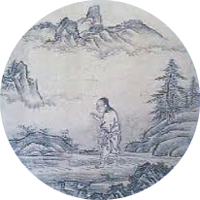 |
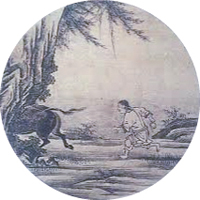 |
Picture. 2. Seeing the Traces |
Picture. 3. Seeing the Ox |
Then he "catches" it and "herds" it. Eventually he finds that he does not need to manage it any longer. |
|
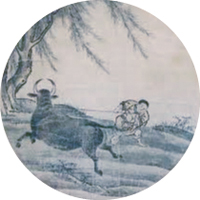 |
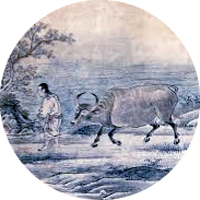 |
| Picture. 4. Catching the Ox | Picture. 5. Herding the Ox |
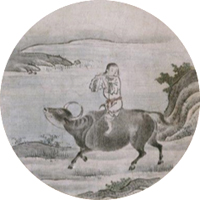 |
|
Picture. 6. Coming Home on the Ox's Back |
|
|
So, in No. 6 we have him "Coming Home on the Ox’s Back," and he
is playing music, letting the ox choose the way. This attitude differs greatly
from that evident in No. 5, in which the youth was guiding the ox.
...Viewing these six in a Jungian perspective, with the youth and the ox indicating the relationship between ego and Self, the sixth may well be said to represent the pinnacle. Here the ego completely relinquishes its initiative to the Self, by which it is being led. The ego sings its own feelings, and the world surrounding it is also peaceful. |
|
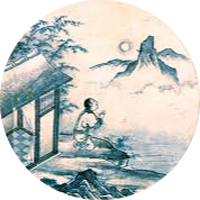 |
But this series indicated a further process. What a surprise to find that,
in No. 7, "Ox Forgotten," the ox disappears! Indeed, man and
the ox have become completely one.
This sort of understanding it generally accepted, but I think that the Self now is manifested not as an ox but as the external environment surrounding the person, taken as a whole. |
Picture. 7. The Ox forgotten, Leaving the Man Alone |
|
| In No. 1, the person was there
all alone. In that sense, No. 7 is the same. However, in No. 1, the person
was there with some sort of feeling loss. In No. 7, you might be able to
see everything surrounding the person as her or his "Self," in
a Jungian sense.
It is interesting that Kuo-an’s inscription for his second painting states: "Embodying all things as self." Then he continues, "He [the youth] has no discrimination between good and evil or true and false. That is to say, he embodies everything as self." No. 7 at first may appear to be quite undifferentiated in terms of self-image and a sense of reality. However, one might say that here it is a conscious undifferentiation, rather than the unconscious undifferentiation of No. 1. It may be an awareness of no separateness or no independent nature. |
|
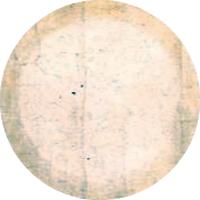 |
|
|
Picture. 8. The Ox and the Man Both Gone out of Sight |
|
| Between Nos. 6 and 7 is a jump, but between No. 7 and No. 8 there is a real leap. Somehow, I could expect the ox to disappear, but is it all right for the person also to disappear? | |
| Then, who is this looking at the circle? |
This is, simply speaking, the experience of death, of Absolute Nothingness. In Zen practice, there
is no higher state that one could wish to attain. Therefore, the tenth
picture in the other version shows such a state, reflecting this point.
We should consider that the two pictures by Kuo-an which follow No. 8 quite possibly are not meant to be developmentally higher. Japanese philosophers Ueda and Yanagita, who specialized in philosophy of religion, explain that 8, 9 and 10 are not positioned as steps of development: "The relationship of mutual penetration is immediately reversible." |
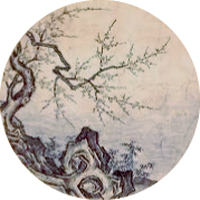 |
|
|
Picture. 9. Returning to the Origin, Back to the Source |
|
Picture No. 9, "Return to the Source," is a painting of a flowing river and a blossoming tree. Ueda sees the transition from No. 8 to No. 9 as "after the cessation, again reviving." At this point, Zen people get into deep and difficult theory, but to me it seems more interesting to think that, since the following picture shows human beings revived from death, human beings would be experiencing "mineral consciousness" and "vegetative consciousness" at this point. These states need not be called "consciousness." But, if you can deal with "Absolute Nothingness" (No. 8), it certainly must be possible to experience animal and vegetative consciousnesses of some sort. Of course, this is just my own arbitrary assumption. |
|
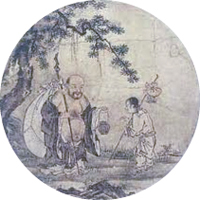 |
|
|
Picture. 10. Entering the City with Bliss-bestowing Hands |
|
|
Two human beings are presented in the tenth picture, "Entering the City
with Bliss-bestowing Hands." Ueda explains that "this last painting
never indicates that the old person, who represents the self, having passed
through various stages, is meeting the young person by accident. The True Self
is becoming two who are facing each other." Two people are united as one
body. However, this union is not similar to the union of the two human beings
in the tenth picture of the Rosarium Philosophorum.
It is interesting that here, even though there is a space between them, these two people are one. This means that there is the possibility of the emergence of dialogue between them: "Who are you?" "Where are you from?" and so on. And there is the possibility of leading back to the first picture. The tenth picture seems to show completion, but it also indicates a return to the beginning..... |
|
| Cited from: Hayao Kawai "Buddhism and the Art of Psychotherapy" (Texas A&M University Press, p. 36-44, 1996) |